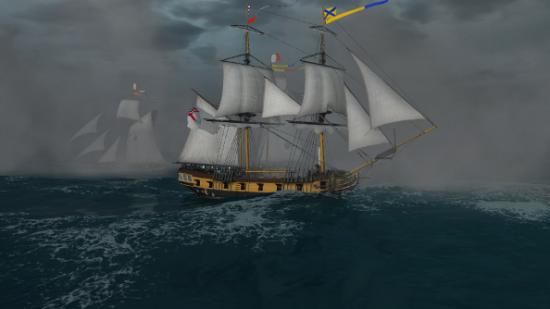Scurvy, cramped living conditions, brine everywhere – life on the high seas during the Age of Sail was as exciting as it was romantic. There was other stuff, too, I suppose. Naval battles, capturing ships, accruing vast wealth… I guess that’s the stuff you want to read about, isn’t it? Fine then.
Created by Ultimate General: Gettysburg developer Game-Labs, Naval Action is a nautical sandbox, a Caribbean MMO where everyone cuts through the ocean on gorgeous ships, making their way in the world by trading, fighting for their chosen nation, or committing random acts of piracy. No parrots in sight, though, because this is serious business.
I’m almost half-an-hour out of Port Antonio, a settlement in the north of Jamaica. My little cutter – my very first ship – has just been repaired after a two-on-two battle against a privateer and another cutter. It is time, I decide, to leave the safe confines of British-run Jamaica; time to head into the ocean and seek my fortunes elsewhere.
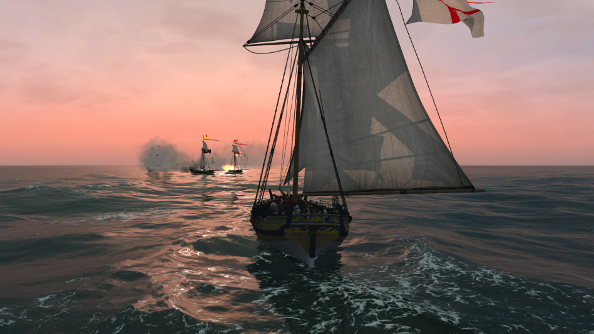
In game-time, I’ve been travelling for days. As Jamaica vanishes behind me, and there’s nothing on the horizon but the intimidating sea, I start to get nervous. My map provides me with lots of information – port locations, trading opportunities – but not where I am. Am I lost? I might be lost.
It’s fine. I’m listening to sea shanties on Spotify and I’ve poured myself a glass of rum. It feels very much like I’m sailing. But the illusion is especially believable because Naval Action sounds so damn authentic. There’s no soundtrack at the moment, but the noise of creaking timber, lapping waves and the Caribbean breeze accompanies me.
Then, in the distance, a mountain. And then the coastline. Despite my doubts, I’ve finally made it to Cuba. Rum! Cigars! Dastardly Spanish ships! I begin my hunt for trading vessels – it’s time to get rich. Actually… it’s not, because before I spot my first plump trader, I notice a less welcome sight on the horizon: player-controlled Spanish ships designed for fighting, not trading. I flee, of course, but by turning around, I’m now sailing against the wind, and my foes catch up to me rapidly. To battle, then.
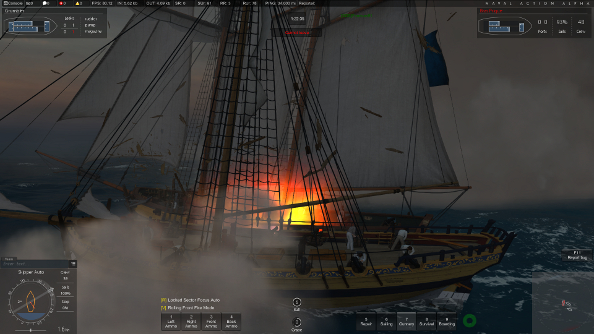
By calling it a battle, I’m probably inflating my worth. Slaughter would be more apt. As the din of cracking and booming cannons filled the ocean, smoke cloaks my enemies, and the wooden hull of my ship starts to look like Swiss cheese. My sails do too. My ship slows, my rudder becomes useless, and then the water starts pouring in. I sink.
I’d like to think that if that battle took place now, I’d have a good, or at least better, chance of winning. In that engagement, on my first day of playing Naval Action, I was fighting like I was in an Assassin’s Creed IV: Black Flag battle, but Naval Action’s combat model is considerably more complex and flexible. Sure, you can just sidle up alongside another ship and unleash a broadside attack, only using the W, S, A and D keys to control your ship’s speed and heading, but you’ll probably end up feeding the fish.
To stand a chance of surviving, you need to be more cautious, more thoughtful, and exert more control over your ship. Instead of just aiming and clicking the left mouse button to unleash an instant barrage, you should fire just one shot. Did it go too far, too high? Make an adjustment. Wait. And then, when you’re sure you’ll score some hits, only then should you fire all cannons, before waiting for them to be reloaded.
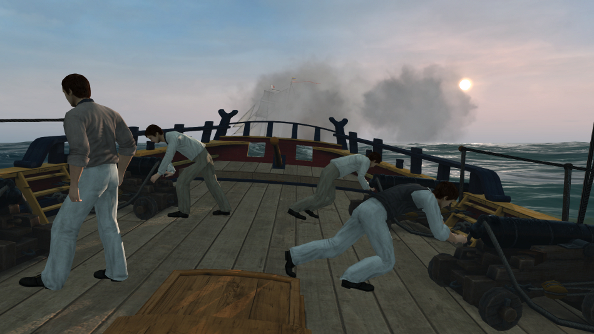
Fine tuning, that’s what it’s about. And using the right shots. Ball shots will damage just about anything and have the best range. Chain shots are perfect for ripping sails and demolishing masts, ensuring that the enemy ship will lose speed. And grape shots – the most deadly of all fruits – are for when you’re so close you can clearly seen the enemy crew, so you can wipe out as many as possible, making it easier to board and capture the ship. Ships don’t have HP, you see; they’ve got men and components that will all be affected by damage in different ways.
All of that information is useless, of course, if you’re still just using the basic movement controls. W and S control the sails, slowing the ship down or speeding it up, while A and S control the rudder. When you’ve only got one mast, then you don’t need to know much more than that – though it’s still important to keep an eye on speed. But with money and experience, bigger ships and crews become available, and that’s when it pays to learn all about making the most of the wind and controlling every yard. Do you know what tacking is? Trust me, you’ll want to.
Last summer, I spent over a week sailing for the first time, and I can honestly tell you that I’ve learned more about sails and yards and tacking by playing Naval Action. Now I don’t fight the wind, I take advantage of it. Without it, by not tweaking the direction of my yards, I can’t make the fast, sharp turns I need to get out of harm’s way or to rapidly change direction so I can take the enemy rudder out of action, or annihilate the crew in a couple of strikes.
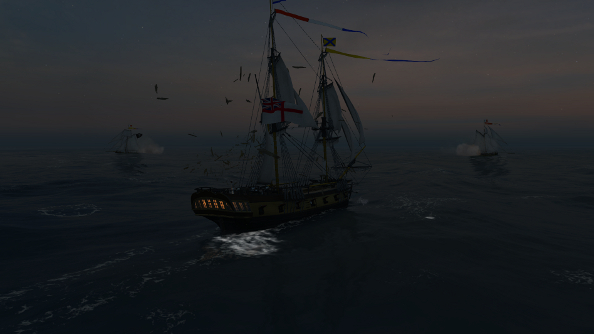
Combat is undoubtedly Naval Action’s best feature at the moment, and PvP is the game’s lifeblood. There’s trading and exploring and crafting (more on that in a bit) but really it’s all about turning enemy vessels into sinking wrecks or just stealing them. It’s a lot more polished than you’d expect from an Early Access game, too. The ship models need a wee bit more work and the UI is ugly even though it’s basically functional, but battles are epic, thrilling, stirring things, utterly engaging and as rewarding as they are tricky.
It would be so easy for them to not be, though. I mean, you’re essentially just floating on the sea, circling another ship, waiting for cooldowns. It’s the small details that makes the fights so compelling, though. The way that even a small wave can completely ruin an attack, or turn a close miss into a devastating hit. The way that smoke from the cannons can sometimes cloud your view, giving you a second of doubt. That satisfying sight when a ball hits and you see splinters flying off a deck or a hull or a mast. The feeling you get when you go from dead in the water to speeding off, narrowingly avoiding a full salvo.
There are always battles to participate in, too. There are missions you get from ports, which offer gold and experience on top of the gold and experience you get from every battle, and these are the quickest ways to work your way up to new ranks, so you can field bigger ships. Once the battle begins, everyone in the surrounding area can see it – or at least a symbol, because fights are instanced – and can join in. It makes them more lively. It’s simply more fun when more ships are involved.
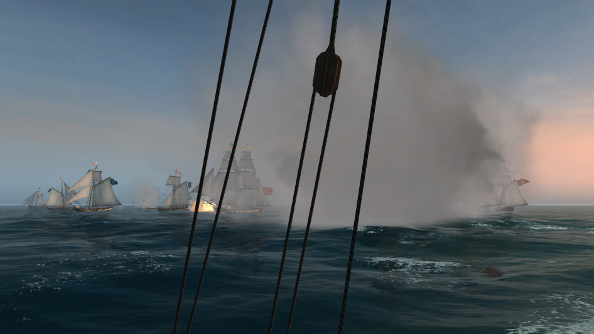
And that brings us to the big PvP battles. Oh my. Whether you’re fighting over a port – factions can capture ports and try to lock down entire areas of the map – or just participating in a random queued battle, they prove to be considerably more elaborate affairs than the standard missions. With 30+ ships, all duking it out, things can get deadly and messy rapidly. Attacks can come from any direction, and not just from enemies. More than once I’ve found myself unwittingly sailing between an ally and a foe as they exchange cannon fire. And crashing into other ships is a very real risk. It’s considered polite to hit the bell key when a collision seems likely, to give captains time to make a course correction. Crashes happen, regardless, though, and usually lead to leaks. Thankfully they can be plugged up by switching from gunnery or sailing mode to survival mode, done at the touch of a button.
What a sight these scraps are. Smoke and bright flashes and explosions and sinking vessels – they are as gorgeous as they are intimidating. And aside from EVE Online and maybe PlanetSide 2, I don’t think there’s another MMO where battles look this awe-inspiring.
Stunning battles aren’t the only thing Naval Action has in common with CCP’s MMO. It has a similar element of risk, as well. Every ship has a level of durability, essentially lives, and once that number hits zero, the ship and everything on it is gone for good. There’s never a time where you’ll have no ships, as the basic cutter is free, but that’s some serious downsizing after getting used to a large frigate, especially if it’s your first, and you’ve spent days and days working for it. It wouldn’t be ahistorical to introduce an insurance system, like EVE’s and Elite’s, but until such a thing does appear, that maxim of don’t fly, or in this case sail, what you can’t afford to lose has never been so true.
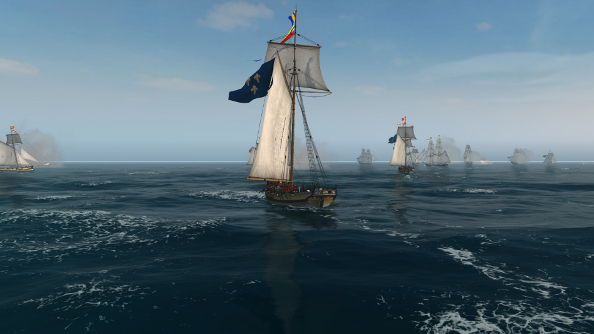
Back before Naval Action launched on Steam Early Access, when it was in a more limited alpha, combat was all there was. So it’s no wonder that conflict is extremely fleshed out. The new parts, the open world elements, where you sail across the Caribbean, exploring, trading and crafting – that’s where the most work still needs to be done.
There are certainly lots of goods that can be bought and sold for profit in countless ports, and crafters will find plenty of things to build, from various cannons and carronades to brand new ships, but the UI is still very early days and doesn’t make the process very user-friendly. A genuinely helpful community does make things easier, though. For instance, if you want to know the value of gold in Kingston, you can just ask in chat, and there’s a good chance that someone will be either in or near the port and check for you. At the very least, it’s more likely than getting told to piss off or to L2P.
One addition above all others would, I think, make navigating the open world considerably more enjoyable, and that’s coordinates. The focus on realism dictates that you can’t just have a mini map or a map of the Caribbean that shows exactly where you are, but crews still used coordinates and navigation charts, and had throughout most of the history of sailing. Without that, you’re really just using a compass and your eyes, which makes it very easy to get lost, especially in weather with poor visibility. That said, there is something a bit exciting about losing your way at sea and finally spotting land and a port ahead of you after you’ve given up hope. But not all the time.
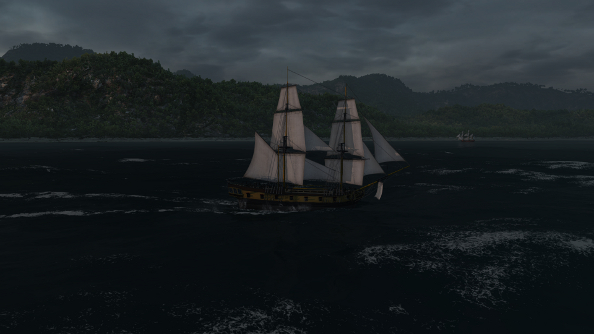
For ship battles, Naval Action is already unrivalled. They might not yet be quite as flashy as Black Flag’s, without the dramatic storms and maelstroms, but they are infinitely more complex and tactical, and the scale of them is significantly greater. It’s smart to be wary of indie Early Access MMOs, but Game-Labs have already constructed a stalwart foundation from which the game can grow, and it’s surprisingly absent a lot of the bugs and performance issues – though some do crop up – that these ambitious projects tend to be rife with.
If you’re fond of EVE, but fancy flitting about during the Age of Sail, prefer your battles to be more balanced between action and tactics, or you just want to play a realistic naval combat sim, then Naval Action, even in its Early Access state, is already more than worth a look.
